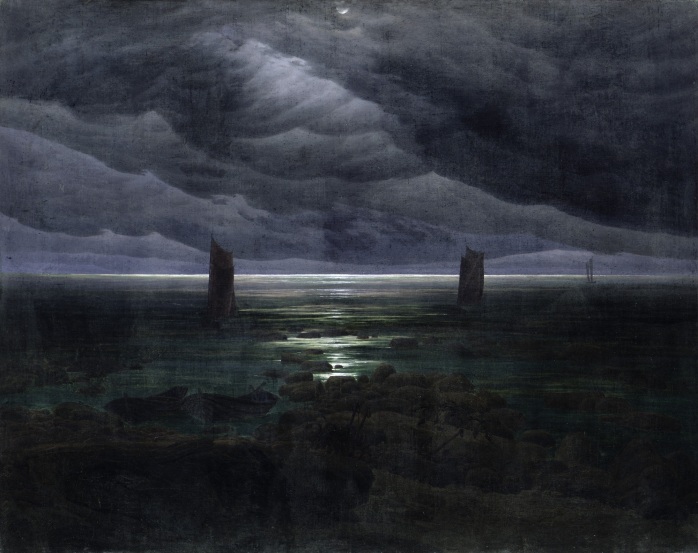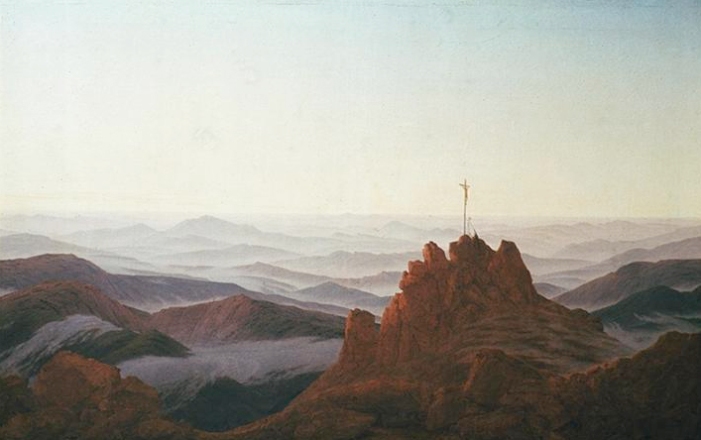Our artistic knowledge isn’t up to much, unfortunately, being students of literature. But from time to time we come across great paintings from the past we love.
Caspar David Friedrich (1774-1840) was a German Romantic landscape painter—we’ve had a thing for his work for some time now.
In March we took a grimace at Goya’s horrifying Saturn Devouring His Son, but Friedrich’s pieces revel in the gothic across a more beautiful and arresting array of emotions.
The Abbey in the Oakwood

The paintaing is far more detailed than initially meets the eye. First off, you see the trees, the dilapidated abbey, and the maudlin sky.
Look closer and there are clearly humans making their way into the abbey. The stark trees suggest it’s winter and the leaves are dead, with the gravestones indicating there’s a funeral taking place.
It ran at an exhibition in 2010 alongside the piece below—seriously, these things must have put the fear of death into everyone.
The Monk By The Sea

This is an oil painting, King Frederick Wilhelm III liked it, and the Abbey painting, so much he bought them.
The idea of the picture, you could argue under the religious pretences of the time, is a lone monk dwarfed by nature; God.
Later, under Hitler’s far right rule, Friedrich’s work was used to support Nazi propaganda. Germans for Germany etc.
Hitler also used certain authors to champion his cause, dismissing the pacifistic All Quiet on the Western Front in favour of the bravado-friendly Storm of Steel.
Sea Shore in Moonlight

Stark imagery again, although we’re not trying to make out Friedrich’s work was only gothic.
You can see below in Morning in the Riesengebirge, he had a contemplative appreciation for morning light (sunlight in general in his other work) and sweeping landscapes.
The beauty of nature, if you will, but placed dastardly alongside an appreciation for the macabre. Note the cross on the hill.

Anyway, please note these works are all in the public domain—we’re not nicking his stuff illegally here.
We’d like to think he’d be happy, heading for 200 years after his death, we’re here documenting his artistic integrity.
As for the artist’s life, he spent a lot of time in Dresden. As you can see in the above paintings, there’s a lot of emotional and religious symbolism.
But he was fascinated by natue (his work has that Copernicus-esque quality in how it’s not about humans. We’re secondary in Friedrich’s pieces) before everything is the beauty of the world.
And he enjoyed success for his efforts. Initially, at least, before he died in obscurity with his art discarded. As above, pieces were put back into the spotlight thanks to the Nazis.
But after WWII was lost, his work took a thrashing again due to its negative representation.
Which, of course, is entirely unfair. We think Caspar David Friedrich is on the level of geniuses such as Vincent van Gogh. If you’re interested, have a search around online to see for yourself.

First 3 kinda creepy lol I like it 😛👻
LikeLiked by 1 person
I think that’s the idea. BWAahahahahaha!
LikeLiked by 1 person
this is very stark and symbolic art by a master artist. I plan to search for more of Fredrich’s art. Thanks for the intro and fine review!
LikeLiked by 1 person
Go for it. The stuff is rather marvellous.
LikeLiked by 1 person
I plan to, thank you!
LikeLiked by 1 person
Apology not accepted.
LikeLiked by 1 person
Oh, really ? Well, I shall find the paintings regardless.
LikeLike
That’s a good idea. Then I’ll accept your apology (for whatever the problem was).
LikeLiked by 1 person
good, I’m off to find Friedrich.
LikeLiked by 1 person
One of my favorite artists! Thanks for sharing these works.
LikeLiked by 1 person
No problem, his work is incredible.
LikeLiked by 1 person